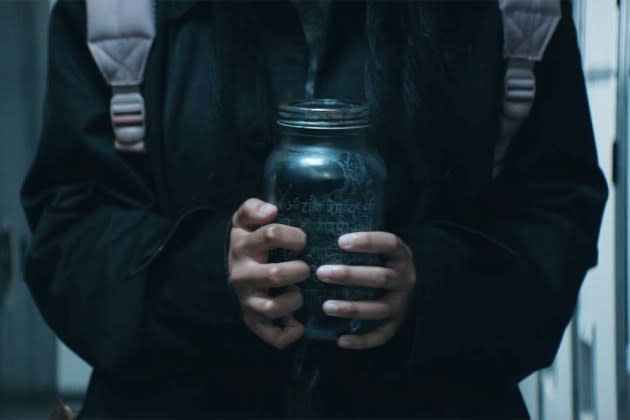‘It Lives Inside’ Review: A Horror Debut About First-Generation Immigrants Falls Short of Its Potential

The encounter in the girls locker room initiates the nightmare scenario of It Lives Inside, Bishal Dutta’s jagged feature debut about a small town besieged by an ancient spirit.
Samidha (Megan Suri) and Tamira (Mohana Krishnan) stand across from each other in the dimly lit aisle, exchanging weighted stares. Culture and a shared history bind the two teenagers, whose reputations differ at their small, white suburban high school. Samidha goes by Sam now — an attempt to close the gap between her Indian culture and the American one embodied by her classmates. She would prefer to loiter around a campfire with her crush (Gage Marsh) than help her mother (Neeru Bajwa) prepare for puja.
More from The Hollywood Reporter
Neon Expands Marketing Team With Alexandra Altschuler, Don Wilcox Joining as Vice Presidents
Sandra Hüller Stars in Trailer for Cannes Palme d'Or Winner 'Anatomy of a Fall'
Tamira is a more shadowy figure; her character seems mostly to be Sam’s opposite. The young woman, dressed in drab and ill-fitting clothes, sticks out. She inspires stares, whispers and jokes. When she shuffles through the hall, it’s as if she’s haunted by an imperceptible force.
Dutta, who co-wrote It Lives Inside with Ashish Mehta, uses Sam, Tamira and a demonic force to explore immigrant isolation. The director is not the first to use horror conventions to clarify these themes: No One Gets Out Alive focused on an undocumented Mexican immigrant in the U.S. and Nanny chronicled the experiences of a Senegalese au pair in New York. But Dutta and Mehta personalize their thesis by shaping their narrative around the tensions in Sam and Tamira’s friendship.
Details, at least at first, matter. The relationship between Sam and Tamira flirts with cliché but is, ultimately, saved by the specificity of the film’s first act and the performances by Suri (Missing, Never Have I Ever) and Krishnan (I Am Frankie). When Tamira greets Sam, her voice is raspy and hushed. There’s a ragged quality to her posture — her eyes peek from behind a mess of hair, her lips are chapped. She tells Sam she needs help, that a demonic spirit, living in the mason jar she carries around, is ruining her life. Sam responds to the fear in her former friend’s eyes, at first with concern, and then with anger. She wants to help, she says, but Tamira needs to tell the truth. Monsters aren’t real, ghosts don’t exist and ancient spirits are the stuff of fiction.
Rage creeps onto Sam’s face. Suri relaxes her furrowed brows and curls her lips into a disappointed smile. “You’re such a fucking psycho,” she hisses at Tamira. And then, as if to sever any other ties between them, Sam shatters the glass. The spirit escapes and Tamira disappears.
It Lives Inside chronicles Sam’s attempt to find her friend. She embarks on a frantic search for clues, asking her mother vague questions and pulling from her patchy memory. The film grips us with its jump scares and Wesley Hughes’ propulsive score. The stakes are high and we believe them — at first.
Somewhere along Sam’s journey, though, the spell breaks. Dutta’s film slackens as it takes increasingly conventional routes and deserts the bolder promises of its premise. Immigrant dislocation, the notion of being stuck between worlds, and the idea of America as a land of opportunity are explored in what feels like a cursory manner. Vague dialogue full of broad sentiments makes the characters feel more like symbols than people. Further details about Sam and Tamira’s friendship or scenes between Sam and her mother (who figures more prominently the closer her daughter gets to solving the mystery) would have lent crucial scenes more texture.
Indeed, that specificity could have also propped up the film’s horror elements. Distance from the characters means that It Lives Inside doesn’t always deliver on fright. Some of the scariest parts of the film take place in the first act, just as we are getting to know Sam and Tamira. Understanding their shared past, sensing the severance and acknowledging that both teenagers still feel alienated adds a haunting layer to the film. When Dutta moves away from focusing on the friendship — shifting gears to explore an underdeveloped love story, for example — it divides our attention and weakens the narrative.
The potency of It Lives Inside — and why it might be worth checking out even if it isn’t wholly satisfying — lies in how it introduces Sam and Tamira’s relationship and links it to Hindu lore. That connection is refreshingly bold, and from it emerge far more interesting questions about the violent isolation of assimilation.
Best of The Hollywood Reporter
Kim Cattrall and Five Actors Who Made Surprising Returns to a Role
10 Times Hollywood Predicted the Scary (or Not So Scary) Future of AI
21 Actors Who Committed to Method Acting at Some Point in Their Career

